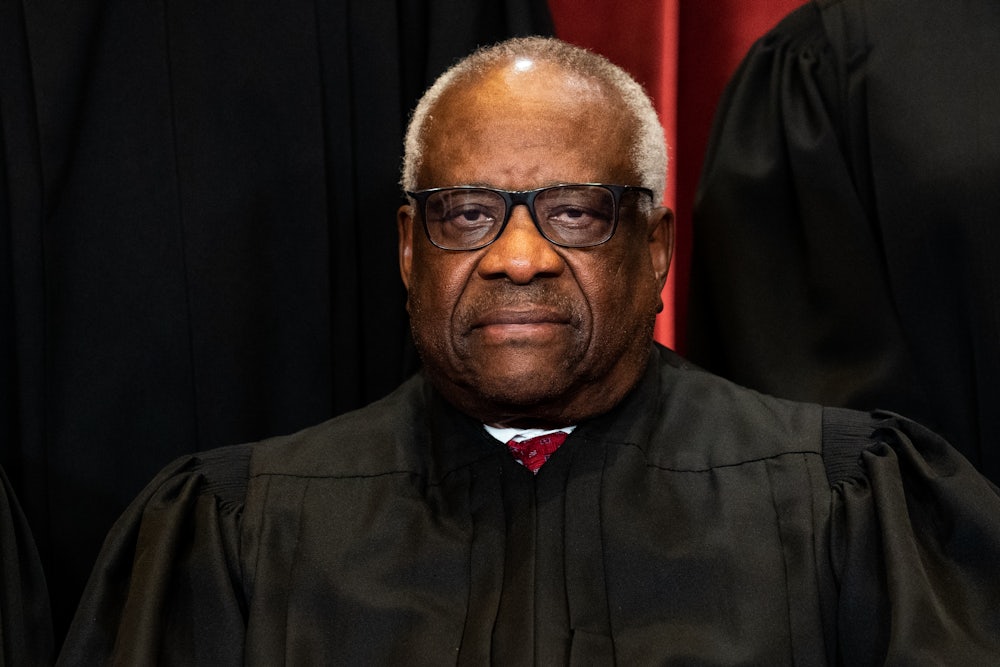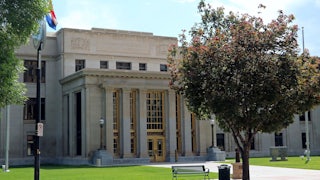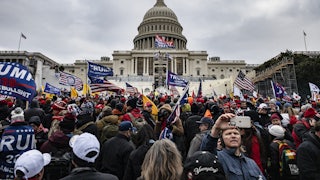The Supreme Court just made it far more difficult to challenge racial gerrymandering by state legislatures. In a 6–3 decision on Thursday that fell along the usual lines, the justices rejected a challenge to a district that was redrawn to favor Republican candidates. But one right-wing justice took the opportunity to go even further, suggesting that the federal courts, including the high court, should not even consider gerrymandering cases in the future. That would have disastrous consequences for Black voters in the South.
Justice Samuel Alito, writing for the court, concluded that the plaintiffs challenging one of South Carolina’s congressional districts had failed to show that the changes were racial in nature instead of partisan. “When partisanship and race correlate, it naturally follows that a map that has been gerrymandered to achieve a partisan end can look very similar to a racially gerrymandered map,” he wrote in Alexander v. South Carolina State Conference of the NAACP.
A far more ominous opinion came from Justice Clarence Thomas. While he largely agreed with Alito’s conclusions, he also wrote a separate concurring opinion “to address whether our voting-rights precedents are faithful to the Constitution.” In it, he suggested that federal courts should not hear racial gerrymandering cases at all, whether they be claims of outright racial gerrymandering or claims of vote dilution.
“In my view, the court has no power to decide these types of claims,” Thomas wrote. “Drawing political districts is a task for politicians, not federal judges. There are no judicially manageable standards for resolving claims about districting, and, regardless, the Constitution commits those issues exclusively to the political branches.”
If adopted by the Supreme Court, Thomas’s opinion would give free rein to Southern states to reduce Black electoral power wherever it is mathematically feasible. His stance that federal courts have no role in redistricting cases at all would also imperil precedents like Baker v. Carr, the landmark 1962 case that articulated the “one person, one vote” rule. The Warren court dragged America into liberal democracy in the 1960s; Thomas wants to drag the country back out of it.
Like most gerrymandering cases, this one began with the last redistricting cycle. After the 2020 census, South Carolina lawmakers moved tens of thousands of Black voters out of the state’s first congressional district and into a neighboring solid blue one held by Representative Jim Clyburn. That shift turned what had once been a competitive House seat into a safer Republican one currently held by Representative Nancy Mace.
As a result, the GOP holds 85 percent of South Carolina’s congressional seats even though one-third of South Carolina voters chose Democratic candidates in 2022. A local NAACP chapter and its allies sued the state legislature to block the map on racial gerrymandering grounds. Last year, a federal district court ruled that state lawmakers had effectively “bleached” the first congressional district to achieve their goals.
State lawmakers insisted that their goal was a partisan one, not a racial one. This would be pretty safe legal ground for them. In the 2019 case Rucho v. Common Cause, the Supreme Court ruled that federal courts could no longer hear partisan gerrymandering cases. Since partisan identification can be a proxy for race in South Carolina and other Southern states, however, the challengers argued that this excuse was a flimsy one.
To say that Alito took a favorable view of the state lawmakers’ arguments would be an understatement. Writing for the court, he suggested that accusing state lawmakers of racial gerrymandering was worse than racial gerrymandering itself. “We should not be quick to hurl such accusations at the political branches,” he wrote. He argued that state lawmakers were entitled to a strong “presumption of good faith” when carrying out their redistricting duties and erected new barriers to future racial gerrymandering challenges.
In a scathing dissent, Justice Elena Kagan condemned Alito for what she saw as myriad errors on his part. She noted that precedent had required the justices to give “significant deference” to a lower court’s factual findings. In her view, the plaintiffs had “introduced more than enough evidence of racial gerrymandering to support the district court’s judgment,” which should have resolved the case in their favor under the court’s existing rules.
But it didn’t. “The majority’s attempt to explain its contrary result fails at every turn,” Kagan wrote, joined by Justices Sonia Sotomayor and Ketanji Brown Jackson. “The majority picks and chooses evidence to its liking; ignores or minimizes less convenient proof; disdains the panel’s judgments about witness credibility; and makes a series of mistakes about expert opinions.”
How Kagan refers to Alito and her conservative colleagues here is also a subtle but noteworthy jab at them. Supreme Court justices have a long history of referring to each other in unusually formal ways. For example, up until the end of the twentieth century, they often addressed each other as “my brother” or “my brethren,” even when sharply disagreeing with one another. This practice fell into disuse when Sandra Day O’Connor’s appointment in 1981 made it untenable.
When justices refer to the majority opinion and its author in their formal writings today, they also typically refer to “the court.” The premise is that the majority opinion’s author is not merely speaking for themself but for the Supreme Court as an institution in delivering a ruling. Kagan dropped that pretense here by simply describing Alito and the other conservative justices as “the majority,” as if to suggest that this decision is not the result of legal judgment, but mere votes.
Kagan’s disdain appeared to be largely directed at Alito himself. She noted that the court had resolved a “strikingly similar” racial gerrymandering case in the 2017 case Cooper v. Harris. In that case, Alito had dissented from the court’s ruling and called for it to adopt a variety of measures that it now imposed in this case. Kagan accused Alito of laundering his dissent in that case into the judgment of the court in this one.
“The [Cooper] Court rejected the state’s request for an alternative-map requirement; the dissent vehemently objected,” she wrote. “The court applied normal clear-error review, deferring to all plausible trial court findings. The dissent, invoking a presumption of good faith, instead deferred to all plausible arguments of the losing state defendant. Today, for all practical purposes, the Cooper dissent becomes the law.”
While Kagan did not address Thomas’s concurring opinion, its existence may explain some of her vehemence. Thomas argued for the reversal of more than a half-century of Supreme Court precedent on gerrymandering cases, which would have vast implications for how American political systems are structured. He argued that the elections clause in Article I offers no room for federal courts to address gerrymandering.
“The Elections Clause’s text and history therefore point to the same conclusion: The Clause commits supervisory authority over congressional districting to Congress alone,” he wrote, paraphrasing from Rucho. “‘At no point’ during the drafting or ratification of the Constitution ‘was there a suggestion that the federal courts had a role to play’ in resolving ‘electoral districting problems.’”
The basis for most racial gerrymandering claims, however, is the Fourteenth Amendment’s equal protection clause. Even Alito acknowledged as much in his majority opinion: In describing the level of judicial scrutiny that courts apply in some circumstances, he noted that the prevailing standard is “extraordinarily onerous because the Fourteenth Amendment was designed to eradicate race-based state action.” Alito cited the court’s decision in Students for Fair Admissions v. Harvard last term, which largely abolished affirmative action in higher education.
Thomas read the equal protection clause more narrowly. He said its command that no state shall “deny to any person within its jurisdiction the equal protection of the laws” only applied to protecting “persons and property” from “violence” and allowing them to “enforce their rights through the court system.” (This apparently does not include their voting rights.) As a result, he argued, the Fourteenth Amendment does not “prohibit discriminatory legislative classifications.”
This is a stunning position, to say the least. It is difficult to take seriously the claim that the Fourteenth Amendment’s drafters sought to build and preserve multiracial democracy in the Southern states. It beggars belief that they would have taken such a narrow view of its protections when they intersect with the political process.
Thomas’s stance is even more bewildering considering how he writes about the equal protection clause in other contexts. His position is that the Fourteenth Amendment unequivocally forbids the consideration of race in college admissions but happily tolerates it in the redistricting process. To square that circle, Thomas argued that when federal courts remedy racial gerrymandering by state legislatures, they themselves engage in a form of racial gerrymandering that is plainly unacceptable.
“Any use of race in drawing political districts—no matter how minor—must be justified by a compelling interest,” he wrote. “The court’s insistence on hearing nonjusticiable districting claims leads it to disregard that principle in favor of a distorted standard that legitimizes racial classifications. If the court is truly concerned about intruding on the political process, it should acknowledge that districting is a political question and vacate the field.” This is not a solution to racial gerrymandering, of course; it is encouragement of it.
Perhaps the most startling portion of Thomas’s opinion is when he discusses Brown v. Board of Education. As part of his broader argument, he expressed discomfort with what he saw as the heavy hand of federal courts in racial gerrymandering cases. The federal courts’ remedies for gerrymandering can include deciding which map an upcoming election is held under, ordering the state legislature to draw a new map for future elections, and even drawing a map itself if the state legislature fails to comply.
Thomas argued that the federal courts once recognized greater limits on their own power to provide relief. But the Supreme Court went astray, he claimed, after its ruling in Brown. Most Americans probably think of Brown as a singular case; it actually encompasses a series of rulings. The Supreme Court delivered the famous one against segregation in public education in 1957. It then spent years trying to overcome the South’s defiance of the first ruling. Thomas argued that the court’s remedies in the latter cases went beyond what the Constitution allowed.
“In doing so, the Court took a boundless view of equitable remedies, describing equity as being ‘characterized by a practical flexibility in shaping its remedies and by a facility for adjusting and reconciling public and private needs,’” he wrote, quoting from Brown II and then later from his previous writings. “That understanding may have justified temporary measures to ‘overcome the widespread resistance to the dictates of the Constitution’ prevalent at that time, but, as a general matter, ‘such extravagant uses of judicial power are at odds with the history and tradition of the equity power and the Framers’ design.’”
Expressing heterodox opinions is nothing new for Thomas. He has dissented more frequently than any of his contemporaries and has called for more of the court’s precedents to be overturned than any other justice. Thanks to the Supreme Court’s conservative supermajority, however, his disagreements with precedent tend to find their way into future majority rulings. The only question now is how many of his colleagues agree that Black voters in the South should be left to the mercy of gerrymander-happy state legislatures. The justices’ willingness to upend precedent in Thursday’s ruling gives little comfort.






